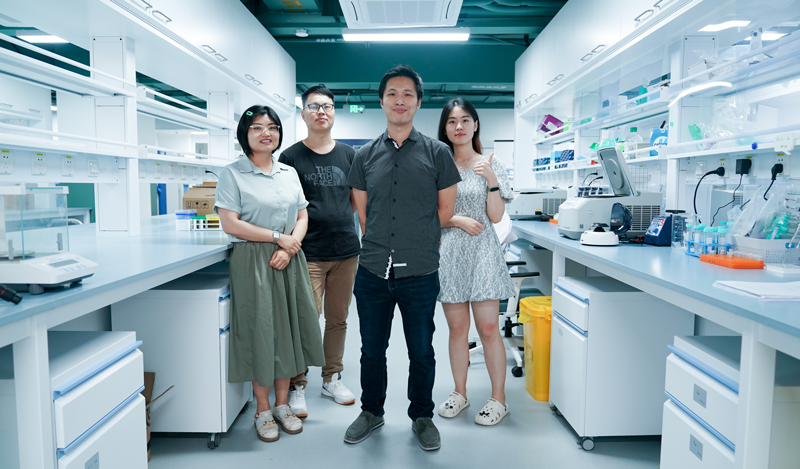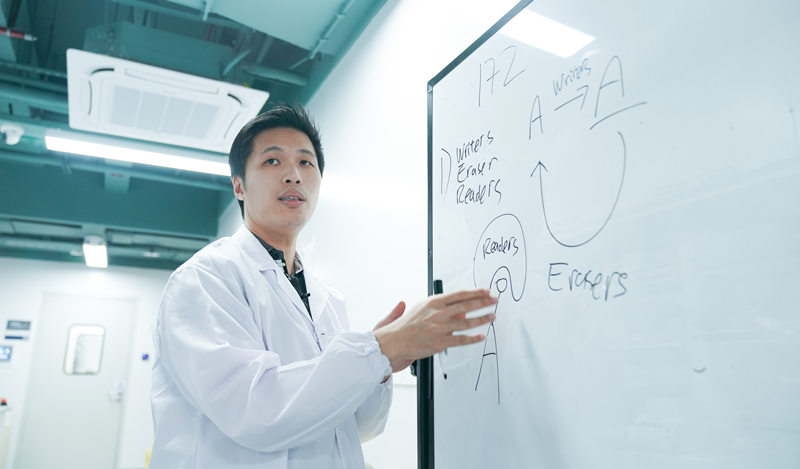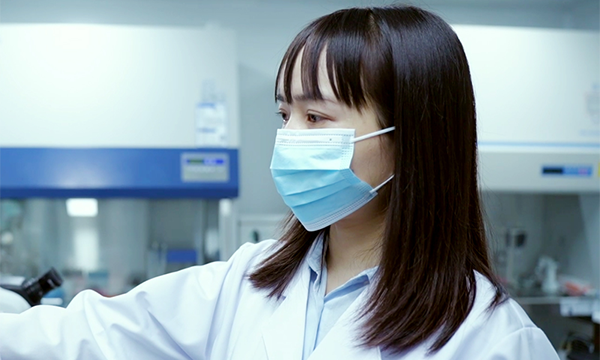"
WEE SIONG GOH, also known as Sho Goh, a scientist from Singapore, is one of the principal investigators at Shenzhen Bay Laboratory’s Institute of Molecular Physiology.
来自新加坡的吴炜祥是深圳湾实验室分子生理学研究所特聘研究员。
Sho received his bachelor’s degree in bioengineering from the University of Pennsylvania in the U.S. and his Ph.D. degree from Cold Spring Harbor Laboratory, a private nonprofit research institution in the Long Island of New York State.
吴炜祥本科毕业于美国宾夕法尼亚大学,在纽约州长岛的冷泉港实验室获得博士学位。

Sho (2nd R) and his team members pose for a group photo at his lab on June 16.
He came to Shenzhen Bay Laboratory in 2020 and has built a team that develops new technologies to sequence RNA modifications, find factors that influence RNA modifications, and observe how RNA modifications affect molecules, cells, tissues, organs and human bodies.
2020年,吴炜祥加入深圳湾实验室。他率领的课题团队通过研发新技术检测RNA修饰,并追踪影响RNA修饰的因素,观察它们对分子、细胞、组织、器官和人类个体产生的影响。
We know that RNA, or ribonucleic acid, is typically a single-stranded biopolymer. Now, let’s imagine them as words that can be formatted. They can be underlined, highlighted, made bold, italic, or have their colors changed. This formatting is analogous to RNA modification.
我们知道,核糖核酸是一类单链的生物聚合物。现在我们暂时把它们想象为一个个单词,通过添加下划线、高亮、加粗,将字体改为斜体,或者改变其颜色,可以修改其格式。这种调格式的过程类似于RNA修饰。

Sho explains what an RNA modification is during an interview with Shenzhen Daily on June 16.
Different RNA modifications play different roles in our bodies. Sho and his team study how RNA modifications influence the health of human bodies and how to develop therapies for different diseases caused by defects in various RNA modifications.
不同的RNA修饰在人体中扮演不同的作用。吴炜祥和他的团队研究的就是RNA修饰对人类健康的影响,并为由RNA修饰缺陷引起的疾病研发治疗方法。
In our body, certain proteins are responsible for writing, erasing and reading RNA modifications. For Sho’s team, the first strategy is to find out what are the writers, readers and erasers.
在我们体内,某些蛋白质负责书写、擦除和识别RNA修饰。在吴炜祥团队的研究工作中,第一步是找出修饰酶、修饰识别酶以及去修饰酶。

Sho performs an experiment at his lab at Shenzhen Bay Laboratory in Guangming District on June 16.
To manipulate an RNA modification, one must first identify where it is. For the team, the second strategy is developing new technologies to sequence and map the locations of RNA modifications.
如果要控制RNA修饰,首先需要确定其位置。因此,对团队来说,第二步是开发新技术,对RNA修饰的位置进行测序和定位。
With all the information collected from the first two strategies, the team comes to the third strategy: understanding how different RNA modifications impact different diseases and developing therapies based on studying RNA modifications.
通过前两步收集到必要的信息之后,团队则进入第三步的工作:认识不同的RNA修饰如何影响不同的疾病,并在研究RNA修饰的基础上开发治疗方法。
Through these three overlapping strategies, Sho and his team are gradually approaching their ultimate goals.
通过这三种交叉的策略,吴炜祥团队正在逐步实现他们的最终目标。
来源:Shenzhen Daily














